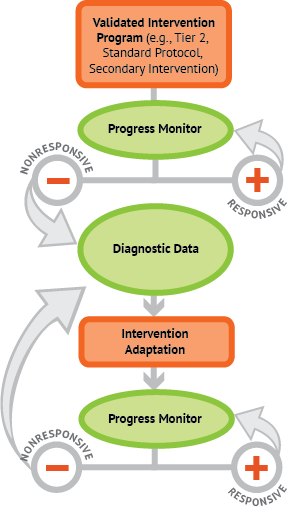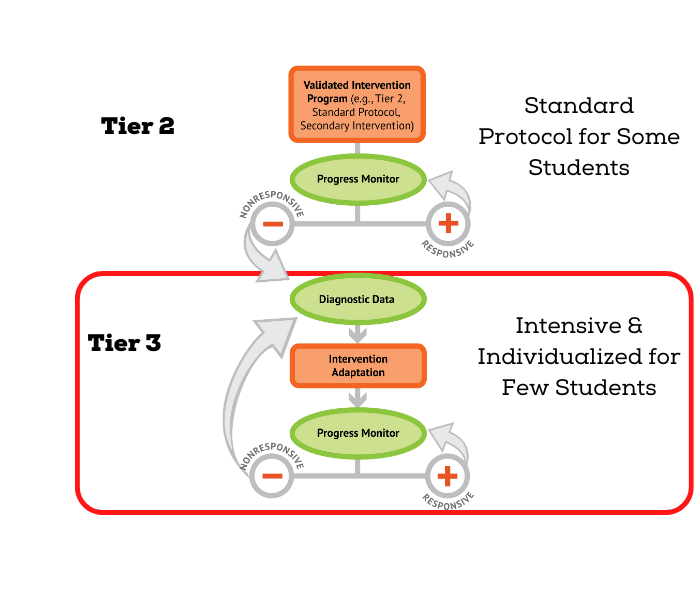Tier 3 Overview: Academic - Social Emotional - Behavioral
Intensive intervention, or Tier 3, is the most intense level in a multi-tiered system of supports (MTSS). At Tier 3, a student-centered team process is utilized to support individual students with intensive needs. Research suggests that intensive intervention will be needed for about 5-10% of students, including students with disabilities, to be successful in a multi-tiered system of supports (Fuchs et al., 2008; NCII, 2013). The process we use in Rhode Island for intensifying is called Data-Based Individualization (DBI). DBI is driven by data, characterized by increased intensity and individualization, and considers the student's academic and behavioral strengths and needs (National Center on Intensive Intervention, 2013). These students may include:
- Students who have not responded to an otherwise effective evidence-based Tier 2 intervention delivered with fidelity.
- Students that screening data indicate have an urgent intensity of need or where there is a sudden onset of intense behavior.
- Students with Individualized Education Programs (IEP) who are not making adequate progress in meeting IEP goals.
For students with the most intensive social-emotional and behavioral needs, Tier 3/intensive intervention may involve a wrap-around, team-based approach that may also include community providers. These students often have academic and social/behavioral needs, so this team is multidisciplinary and considers the "Whole Child" while using the data-based individualization process.
DBI requires the integration of validated interventions and assessments across the five steps (Peterson, Danielson, & Fuchs, 2019) shown in the graphic below. Click each corresponding tab below to learn more.
 |
The DBI process begins with a validated intervention platform delivered to a group of students in a standard way. Often called Tier 2, or a standard-protocol intervention, this platform provides targeted instruction in either a specific skill or a set of skills (e.g., phonemic awareness, vocabulary, math problem solving, social skills, self-regulation) matched to students' needs and delivered with fidelity. Any student (e.g., including students with disabilities) who has the targeted need(s) has access to the intervention. This intervention is in addition to core instruction, not in place of it. Student behavior will not change if the adults in the system do not change the environment and their behavior in support of students. Schools should consider a series of dimensions called the Taxonomy of Intervention Intensity when evaluating the validated intervention program: strength, dosage, alignment, attention to transfer, comprehensiveness, and behavioral support. Then, interventions are organized in a map to support the adults in implementing with fidelity, communicating and coordinating roles, and supporting carryover into other school settings. Teachers use informal, often unstandardized, assessment approaches to make immediate, real-time instructional changes every day in schools, but this differs significantly from progress monitoring within a MTSS. Progress monitoring in a MTSS refers to standardized, valid, and reliable tools (i.e., General Outcome Measures, Direct Behavior Rating, Daily Report Card, etc.). After sufficient data are collected (e.g., weekly for six to nine data points on reading GOMs), they are graphed and evaluated against the student’s instructional or social-emotional/behavioral goal to determine whether the student is making sufficient progress. After sufficient data have been collected and graphed (e.g., six to nine data points on reading GOMs), progress is evaluated against the student’s instructional or social-emotional/behavioral goal to determine whether the student is making sufficient progress. If the trendline is above the goal or aimline, then the response to the intervention program is adequate to close the gap. We celebrate and continue with the intervention until the goal is reached.
After sufficient data have been collected and graphed (e.g., six to nine data points on reading GOMs), progress is evaluated against the student’s instructional or social-emotional/behavioral goal to determine whether the student is making sufficient progress. For social-emotional-behavioral goals, the focus should be on replacement skills and/or behaviors, with progress monitoring measuring growth in that area, which should then correlate with a decrease in problem/maladaptive behavior. If the trendline (performance) is below the goal or aim-line, then the response is not (yet) adequate. We move to the next step in the intensification process. In most cases, students with severe and persistent learning needs, including students with disabilities, will require several rounds of adaptation before progress is sufficient. If at any time the team or a family member suspects a disability, a special education evaluation referral should be initiated. The data collected through the intervention and intensification/DBI process can be used in the referral and evaluation processes and to inform existing IEPs and 504 plans.
When progress in response to an intervention implemented with fidelity is inadequate, the student-level team needs to dig deeper. In this step of DBI, a team engages in a diagnostic process to develop a hypothesis about the potential cause(s) of the student’s academic and/or behavioral difficulties. This hypothesis drives the team’s decisions about how best to support the student and adapt the intervention. In Rhode Island’s model, since academic and behavioral needs don’t exist separately from one another, we conceptualize a diagnostic process that hypothesizes if the need is an “isn’t doing” (i.e., relationship, engagement, and motivation), a “trouble doing” (i.e., difficulty performing the skill automatically and generalizing it to new situations), or a “can’t do” (i.e., skill deficit/instructional mismatch possibly indicating the need for a different intervention). In the social-emotional/behavioral realm, this process may include a simple Functional Behavior Assessment (FBA) (i.e., FACTS), extensive FBA, or Collaborative Problem-Solving Assessment of Problems to be Solved and Lagging Skills. After completing a diagnostic process and hypothesizing the nature of a student's struggle, the team moves on to plan adaptations to better meet these individual needs. The plan often identifies a clear focus (i.e., addressing barriers to intervention fidelity such as absences, addressing an 'isn’t doing,' a 'trouble doing,' or a 'can’t do' hypothesis). The intensification plan also defines who is responsible for which part of the plan and by when. For some more complex SEB needs, family-school-organization wrap-around may be needed. A staff member or a Family Care Community Partnership’s partner will function as a coordinator aligned with memoranda of agreement established between the school and community providers. Finally, the team sets the date when they will come together after having implemented the intensification plan to see if it worked. Recall that students with the most complex needs, including students with disabilities, may require several rounds of adaptation before progress is sufficient. The process repeats until we figure it out - together. Go team! The quality and fidelity of Tier 1 and Tier 2 set the foundation for the successful implementation of intensive intervention. Schools/teams focusing on Tier 3 often find it necessary to improve their Tier 1 and 2 systems as part of continual school improvement to better meet the needs of their most complex learners (National Center on Intensive Intervention, 2022). |
|---|
Learn More About Tier 3
If you're interested in improving your school's implementation of Tier 3, be sure to check out BRIDGE-RI's strand of courses devoted to this topic. Beginning with the Tier 3 Overview course, you'll learn more about the practices, data, and systems needed to support an effective Tier 3. See all current Tier 3 course offerings. Please note that you must have an account with BRIDGE-RI to enroll in courses. Sign up today - it's free and easy!

Data-Based Individualization, National Center on Intensive Intervention (n.d.) Text-only version of the Data-Based Individualization graphic
